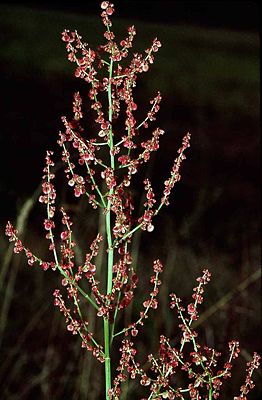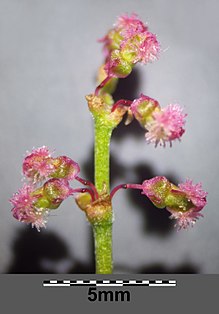Ostrich-flowered sorrel
| Ostrich-flowered sorrel | ||||||||||||
|---|---|---|---|---|---|---|---|---|---|---|---|---|

Ostrich-flowered sorrel ( Rumex thyrsiflorus ) |
||||||||||||
| Systematics | ||||||||||||
|
||||||||||||
| Scientific name | ||||||||||||
| Rumex thyrsiflorus | ||||||||||||
| Fingerh. |
The ostrich-flowered sorrel ( Rumex thyrsiflorus Fingerh .; Syn .: Rumex acetosa subsp. Thyrsiflorus ), also known as panicle sorrel , is a member of the knotweed family (Polygonaceae) that only occurs in parts of Central Europe.
description
The ostrich-flowered sorrel is a perennial , herbaceous plant that can grow to heights of up to 120 cm. It is dioecious separate sexes ( diocesan ).
The very differently shaped leaves are usually linear to narrowly lanceolate and have an arrow-shaped to spear-shaped base. Sometimes the individual corners of the skewer are also split. The leaves are about four to 14 times as long as they are wide. The basal leaves are long-stalked, while the upper stalk leaves encompass the stems. The transparent sheaths ( ochrea ) of the stipules are slit.
The richly branched branches of the inflorescence form dense panicles in the fruit state .
The inner, membranous tips of the flower cover ( valves ) are kidney-shaped to rounded, about 2.5 to 3.5 mm long and often wider than they are long. They have at least one small, flattened, curved callus . The dark brown nuts reach sizes of around 1.8 to 2.2 mm.
The ostrich-flowered sorrel blooms mainly in July and August.
The number of chromosomes is 2n = 14 in females, 2n = 15 in males.
Occurrence
Rumex thyrsiflorus occurs from Scandinavia across eastern Central Europe and the Balkan Peninsula to Siberia and China. In Central Europe, the species reaches its western border, but shows a clear tendency to spread along the major transport routes.
In Germany, the ostrich-flowered sorrel is common in eastern Germany. In addition, it is particularly widespread along large rivers (Stromtalpflanze), as well as along large streets and railways. In Austria and Switzerland, the species is also found as neophytes, predominantly scattered to fairly often along the major traffic routes.
Rumex thyrsiflorus grows on roadsides, railway embankments and other ruderal places. It prefers more or less dry, often stony or sandy soils. It thrives in societies of the associations Dauco-Melilotion, Arrhenatherion, Mesobromion and also in other societies of the class Agropyretea.
literature
- Sebald, Seybold, Philippi: The fern and flowering plants of Baden-Württemberg , Ulmer Verlag, Stuttgart, 1990 ISBN 3-8001-3323-7
- Henning Haeupler , Thomas Muer: picture atlas of the fern and flowering plants of Germany (= the fern and flowering plants of Germany. Volume 2). Published by the Federal Agency for Nature Conservation. Ulmer, Stuttgart 2000, ISBN 3-8001-3364-4 .
- Wolfgang Adler, Karl Oswald, Raimund Fischer: Excursion flora of Austria. Ed .: Manfred A. Fischer . Ulmer, Stuttgart / Vienna 1994, ISBN 3-8001-3461-6 .
- August Binz , Christian Heitz: School and excursion flora for Switzerland , Schwabe & Co. AG, Basel, 1986, ISBN 3-7965-0832-4
- Erich Oberdorfer : Plant-sociological excursion flora , Ulmer Verlag, Stuttgart, 1990, ISBN 3-8001-3454-3
- August Garcke : Illustrierte Flora , 1972, Verlag Paul Parey, ISBN 3-489-68034-0
Individual evidence
- ↑ a b Erich Oberdorfer : Plant-sociological excursion flora for Germany and neighboring areas . 8th edition. Verlag Eugen Ulmer, Stuttgart 2001, ISBN 3-8001-3131-5 . Page 331.
- ^ Rumex in the Germplasm Resources Information Network (GRIN), USDA , ARS , National Genetic Resources Program. National Germplasm Resources Laboratory, Beltsville, Maryland. Retrieved August 17, 2017.
Web links
- Ostrich-flowered sorrel. In: FloraWeb.de.
- Distribution map for Germany. In: Floraweb .
- Rumex thyrsiflorus Fingerh. In: Info Flora , the national data and information center for Swiss flora . Retrieved October 5, 2015.
- Distribution in the northern hemisphere as Rumex acetosa subsp. thyrsiflorus according to: Eric Hultén , Magnus Fries: Atlas of North European vascular plants 1986, ISBN 3-87429-263-0
- Thomas Meyer: Data sheet with identification key and photos at Flora-de: Flora von Deutschland (old name of the website: Flowers in Swabia )

